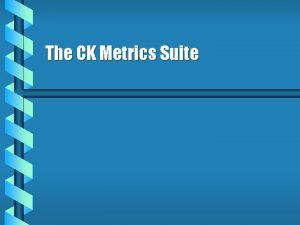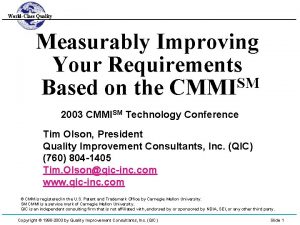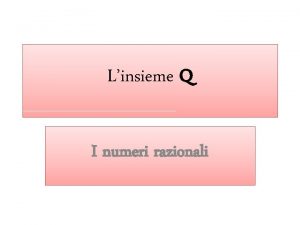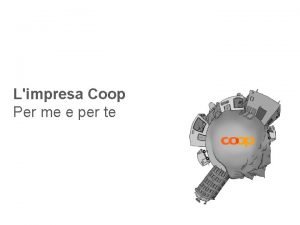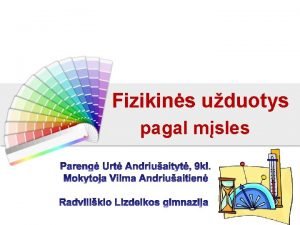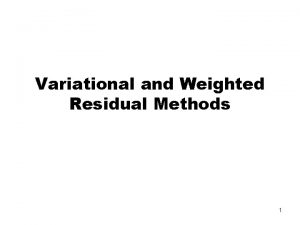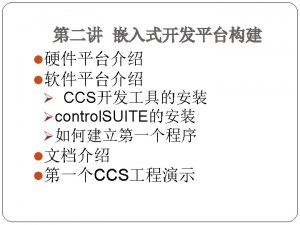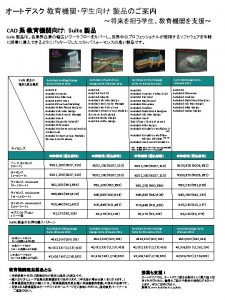The CK Metrics Suite Weighted Methods Per Class










- Slides: 10

The CK Metrics Suite

Weighted Methods Per Class b To use this metric, the software engineer must repeat this process n times, where n is the number of methods for the given class. In order to complete this process, the software engineer must do the following, – Compute the complexity of the method, using a specific complexity measure. Please see links for more information on complexity metrics. – Input the value into the text box. – Click the Add button. – Continue process until all methods have been completed.

Depth of Inheritance Tree b In order to calculate this metric, the Software Engineer must consult their Inheritance tree. b An Example of this is as follows, b To find this, the Software Engineer must traverse the tree until the deepest child has been visited. It is then this number that should be entered. b In the preceding example, the number to be entered into the cell would be 4.

Number of Children b In order to calculate this metric, the Software Engineer must consult their Inheritance Tree. b An Example of this is as follows, b To calculate this metric, the Software Engineer must calculate the number of children that are one level below the class under calculation. b In the preceding example, the number of children for C 2 is 3 (C 21, C 22, C 23).

Coupling between Object Classes b In order to find the coupling between object classes, the Software Engineer must consult his/her set of CRC cards. b To find this value, the Software Engineer must do the following, – Obtain the class under calculation CRC index card. – Count the number of collaborations listed for the class. – Input this number into the cell.

Response for a Class b In order to calculate responce for a class, the Software Engineer must do the following, – Consult the classes CRC index card. – Take the first message and count the number of methods that can potentially be executed in response to this message – Record this number, and repeat this process for all methods. – When finished, input the greatest number into the cell.

Lack of Cohesion in Methods b In order to calculate the lack of Cohesion in methods, the Software Engineer must consult their CRC index cards. They should then do the following, – Pick the first attribute. – Go through the list of CRC cards and count the number of cards that access that particular attribute picked in step one. – Record this number and repeat until all attributes have been processed. – Take the greatest number and input this number into the cell.

Example of CK Metrics b For the first box enter 0. 76 , 0. 76, 0. 79 the hit ok after each one. b For the remaining boxes enter 5 b Formula for calculations WMC = S Ci b Weighted Metrics Class = Sum Classes b

CK Metrics Summary b Weighted Methods Per Class (WMC): 0. 77 b Depth of Inheritance Tree (DIT): 5 b Number of Children (NOC): 5 b Coupling between Object Classes (CBO): 5 b Response for a Class (RFC): 5 b Lack of Cohesion in Methods (LCOM): 5

CK Metrics Suggestions b 1. Your Weighted Methods Per Class Metric is high thus limiting the potential reuse of this class. b Therefore, you may want to reduce the number of methods and/or their complexity b 2. The Depth of Inheritance Tree is high thus increasing the design complexity. b Therefore, you may want to reduce the use of Inheritance. b 3. The Number of Children for this class is high thus diluting the abstraction of the parent class and increasing the amounf of testing. b Therefore, you may want to reduce the number of children. b 4. The Coupling between object classes is high thus reducing the reusability of a class and complicating modifications and testing b Therefore, you may want to reduce the number of collaborator class by combining similar collaborators. b 5. The Response for a class is high thus increasing the testing effort, test sequence and the overall design complexity of the class b Therefore, you may want to reduce the number of operations that maybe execute in response to a message recieved b 6. The Lack of Cohesion in Methods is high thus increasing the complexity of class design b Therefore, you may want to reduce the lack of cohesion in methods by breaking down the class into two or more seperate classes.
 Ck metrics in software engineering
Ck metrics in software engineering Weighted code in digital electronics
Weighted code in digital electronics Methods and metrics for cold-start recommendations
Methods and metrics for cold-start recommendations Operational definition psychology examples
Operational definition psychology examples Indirect wax pattern
Indirect wax pattern Approssimazione per difetto e per eccesso
Approssimazione per difetto e per eccesso Coop per te
Coop per te Il mio diletto è per me e io per lui significato
Il mio diletto è per me e io per lui significato Ka tik pamato pats tuo pavirsta
Ka tik pamato pats tuo pavirsta 186 282 miles per second into meters per second
186 282 miles per second into meters per second Why one minute has 60 seconds
Why one minute has 60 seconds
